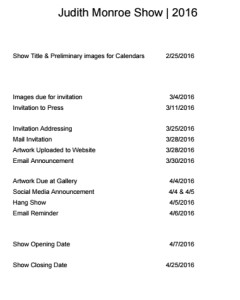
Today’s post is from a little different angle than normal RedDot articles. Today I would like to speak directly to other gallery owners. Though most of my posts are directed to artists, I know that I also have a good number of gallery owners who follow the blog – I appreciate the comments and perspective these gallery owners have offered in comments. I’m offering this post to these gallery owners but also to the many other gallery owners out there who may come across the article.
Today I want to share some advice about working with the artists that you represent. I want to be very careful about my tone – I don’t mean to imply that I know anything more about this subject than anyone else or that I’ve perfected my relationship building skills with the artists I represent. The reality is that much of what I’ve learned, I’ve learned by making mistakes, mistakes that I continue to make from time to time. Today I would simply like to share what I’ve learned and begin a discussion about how we can all better work together.
This post is born of some discussions I’ve had with artists and some tales I’ve heard over the years about the challenges artists and galleries face in their relationships. It’s amazing to me the discomfort, discord, and even animosity that can rise between artists and gallery owners and staff, and if we can start a discussion that helps decrease the tension in some way, I’ll feel it’s been worth the effort.
Obviously, not all of the challenges are created by the galleries – artist’s can just as easily foul up the works. If you look back over past blog posts you’ll see that I’ve spent a lot of time encouraging artists to work with their galleries in a more professional manner. Today I’ll turn the tables.
Perhaps the most important things I’ve come to realize over the years is that we all share the same goal: helping collectors bring art into their lives. As we do so, we all benefit from the sales to those collectors. The better we work together, the more successful we will all be.
Communicate!
I’m convinced that most of the problems that arise between galleries and artists arise out of a lack of communication. I know that managing communication with your collectors takes a tremendous amount of time and effort and that you can feel like you don’t have the bandwidth to spend a lot of time communicating with your artists. It’s amazing, however, how a little bit of effort to interact proactively with your artists can result in a dramatically more successful relationship.
 It’s easy to fall into a routine where you only talk to an artist when absolutely necessary, and the next thing you know a year or longer has passed since you’ve had a conversation with an artist. When this happens, inventory tends to get stale and the energy of the relationship fades.
It’s easy to fall into a routine where you only talk to an artist when absolutely necessary, and the next thing you know a year or longer has passed since you’ve had a conversation with an artist. When this happens, inventory tends to get stale and the energy of the relationship fades.
I would be a hypocrite if I didn’t admit that I’ve been guilty of failure to communicate, but I’ve learned that whenever we put effort into reaching out to our artists we are rewarded for the effort. If you don’t believe me, pick up the phone right now, dial one of your artist’s phone numbers and say “Hi – I’m just calling to see what’s new!” Tell the artist about the reaction you’ve had to his/her work and find out what’s new out of the studio.
It’s obviously even more important to be clear and abundant in your communication if you are planning a show for an artist. Make sure you are crystal clear as you communicate deadlines and promotional requirements.
Get Organized
Another area of conflict arises if you aren’t well organized in your business. Specifically, if you are well organized in your inventory management you will avoid a host of problems as you work with your artists and collectors. A very common complaint I hear among artists as they talk about their experiences with galleries is that a gallery has lost a piece of artwork.
This is a baffling situation for an artist. How can a gallery lose a piece of artwork? It’s understandable that a gallery with hundreds or even thousands of pieces of work in inventory may have to work to find a piece, but, unless the work is microscopic, you shouldn’t lose it!
I suspect that most artwork that goes missing in action was either removed from the gallery by the artist or shipped to another venue without the proper paperwork being created.
Make sure you have a good inventory tracking system in place and that there is never a scenario where new artwork is arriving in the gallery or old artwork leaving without some kind of paperwork being created to note the move.
The goal should be that, at a moment’s notice, you can generate a list of current inventory that matches the actual inventory you have on hand.
Again, we are far from perfect, but we strive to create a certain level of discipline when it comes to inventory control. It’s a lot of work, but it saves a lot more work that will rise when you let your inventory records fall behind.
Plan

Another huge key to success in the gallery business is planning. It’s easy to become complacent with your business, especially if you’ve been at it for a while. Don’t just let business happen, plan! At least annually you should be sitting down to plan out your show schedule and other promotional efforts.
Don’t just put dates on a calendar and call it good – make sure you set up checklists for each event with deadlines for you and the artists you are working with so that you can all work together to build your success.
Communication becomes absolutely critical when you are working together toward an exhibition or other special promotion.
Become a Better Salesperson
Our business revolves around sales – as gallery owners we have to make sure that we and our staff are the best possible salespeople that we can be. Some sales expertise comes with experience, but there’s always more that we can be doing to hone are salesmanship skills.
While selling art is a unique process, it’s not so unique that we can’t learn salesmanship skills from other industries. A quick review of the business section of a bookstore will reveal numerous salesmanship guides that can be read and the knowledge adapted to your gallery.
I remember, early in my career as a gallerist, reading books by Zig Ziglar and other sales experts that opened my eyes to the techniques of salesmanship. Any investment you make in honing your salesmanship will be returned to you many times over in increased sales over the years.
Pay Your Artists Quickly and Reliably
This is a big one. Artists are thrilled when they hear a piece has sold. They are even more thrilled the moment the check arrives. The faster you can get the check into the artist’s hands, the more excited they will be. Excitement translates into better work for your gallery, goodwill, and reputation.
I understand that, as gallery owners, we have to manage cash flow and that you have to be careful to avoid problems if a piece of artwork is returned. It’s become a pretty common practice in the industry to have a 30 day turnaround on artist payments to insulate against returns.
 We were long on a 30 day float for artist payments until my gallery director, Elaine, encouraged me to rethink the policy. Having managed an artist’s business for many years, she convinced me that it would be good business to accelerate the payment. I wasn’t comfortable writing a check to the artist the day the sale happens – we do run into payment or returns from time to time – but we figured out that if we paid as soon as the artwork was delivered to the client’s home and the client had accepted the work and expressed satisfaction with the piece, we wouldn’t run into too many problems.
We were long on a 30 day float for artist payments until my gallery director, Elaine, encouraged me to rethink the policy. Having managed an artist’s business for many years, she convinced me that it would be good business to accelerate the payment. I wasn’t comfortable writing a check to the artist the day the sale happens – we do run into payment or returns from time to time – but we figured out that if we paid as soon as the artwork was delivered to the client’s home and the client had accepted the work and expressed satisfaction with the piece, we wouldn’t run into too many problems.
Our practice now is to contact a client as soon as we receive confirmation of delivery from our shipper to make sure the piece has arrived safely and that they are satisfied. Doing this is actually also great customer service – it lets your client know you care beyond their payment.
Once we’ve received confirmation of delivery and satisfaction from the client, we add the artwork to our list of payables and issue payment on our next weekly check run. This system makes it so that instead of receiving a check 35-40 days after a sale, our artists can expect to receive payment 10-20 days after a sale in most cases – a huge difference.
Nothing will frustrate an artist more than having to wait for an extended period or feeling like they are having to hound you for payment.
I understand that cash flow can be complicated in this business, but I can promise you that if you will prioritize paying your artists quickly you will see the benefits in your business.
If you are using artist’s commission to cover bills, you are masking problems in your cash flow. Worse, once you get behind, it gets harder and harder to catch up.
Treat The Artists You Work With Like Customers, or Even Better, Like Family
I’m going to try to say this without getting myself into too much trouble. I know that working with some artists can be . . . . challenging. Some artists are . . . . . quirky, disorganized, and maybe even slightly neurotic. Sometimes artists will let you down. Sometimes they will make mistakes in their business practices that will drive you crazy.
I try to remember that with artists there is yin and yang. You wouldn’t get the brilliance and creativity if you didn’t also get the challenges – it’s all part of the package.
I figure that, as a gallery owner, it’s part of my job to learn how to work with artists in difficult situations. I try to approach my relationship with my artists by treating them the same way I would treat a client – I want to get to know them, figure out their strengths and weaknesses and find the best ways to communicate on an individual basis with each artist.
As you strive to do everything I’ve talked about in this post, you’ll find that your relationships will stand on firmer ground. As you work together you’ll build relationships that will eventually come to feel like family. It’s at that point that amazing things will happen in your gallery.
What Do You Think About the Artist/Gallery Relationship?
To the gallery owners reading this post, what have you done to build strong relationships with your artists? What has been the greatest challenge as you’ve interacted with them? I’ve been at this for over 20 years, but I know that many of you have been at it longer – I would love to hear any advice you can give to galleries that are striving to build better relationships with their artists.
To the artists reading this post, what have you seen galleries do well as they work to interact with you or with other artists? What do you wish galleries understood better about you as an artist? What do you think galleries could do to increase their success in working with their artists?
Share your comments below!



:strip_icc()/BHG_PTSN19720-33d9cd22f6ab49e6a21982e451321898.jpg)

More Stories
Gurney Journey: USA Today Recommends Dinotopia
“From Generation to Generation…” — A Sanctified Art
The Public Theater’s Under The Radar Festival Lights Up NYC This January